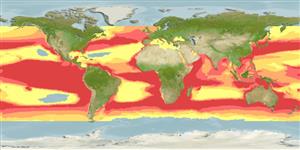Occurs inshore and well offshore (Ref. 5578), over continental and insular shelves (Ref. 244). Coastal, pelagic, and semi-oceanic, but often bottom associated at 1-139 m (Ref. 58302). Migrates northward in summer; young often in large aggregations of hundreds of individuals (Ref. 13562). Prefers to feed on small sharks, skates and stingrays, but also preys on bony fishes, shrimps, crabs, barnacles and cephalopods (Ref. 244). Viviparous (Ref. 50449). Regarded as being dangerous to people, though only few can be tentatively attributed to this species due to its occurrence in temperate waters (Ref. 244). Reported to cause poisoning (Ref. 4690). Caught occasionally by shark and tuna longline fisheries (Ref.58048). Meat utilized fresh, dried-salted, and possibly smoked for human consumption; liver oil for vitamins, fins for soup, hide for leather, and carcasses for fishmeal (Ref. 244). Used in Chinese medicine (Ref. 12166). Become sexually mature when 250 to 300 cm long. The female gives birth to 30 - 40 young (Ref. 35388).
生活于近海与相当外海 (参考文献 5578), 遍及大陆棚与岛屿棚.(参考文献 244) 在夏天向北回游; 常见于数以百计个体的大群集中的幼鱼.(参考文献 13562) 偏爱觅食小的鲨鱼,魟鱼与魟, 也捕食硬骨鱼类,虾,螃蟹,藤壶与头足类动物.(参考文献 244) 胎生的.(参考文献 50449) 被认为在对人类有危险性, 虽然唯一的很少可能是归因于暂时的这种在温带的水域中由于它的发生.(参考文献 244) 报告引起毒害。 (参考文献 4690) 肉生鲜利用,干燥盐腌, 而且可能地烟熏了供人类消費; 肝油用於維他命 , 鰭用於湯, 隱藏用做皮革 , 與殘骸用於魚粉。 (參考文獻 244) 被用於中藥材了。 (參考文獻 12166) 性成熟了當 250 到 300 公分長。 母魚生產到 30- 40個幼魚.(參考文獻 35388)
Preferred temperature (Ref.
115969): 11.8 - 28.9, mean 26.5 (based on 3124 cells).
Phylogenetic diversity index (Ref.
82804): PD
50 = 0.5029 [Uniqueness, from 0.5 = low to 2.0 = high].
Bayesian length-weight: a=0.00398 (0.00298 - 0.00532), b=3.08 (3.00 - 3.16), in cm Total Length, based on LWR estimates for this species (Ref.
93245).
营养阶层 (Ref.
69278): 4.9 ±0.5 se; based on diet studies.
回复力 (Ref.
120179): 低的, 最小族群倍增时间4.5 - 14 年 (tmax=21; tm=8.8; Fec=20-40).
Prior r = 0.28, 95% CL = 0.19 - 0.42, Based on 1 data-limited stock assessment.
Fishing Vulnerability (Ref.
59153): High to very high vulnerability (68 of 100).
Climate Vulnerability (Ref.
125649): Moderate vulnerability (38 of 100).
